Abstract
Advancements in manufacturing technology have facilitated the use of micro-orifice restrictors (MORs) in aerostatic bearings. However, the understanding of their effectiveness in journal bearings remains limited. This study utilizes FEM for solving the nonlinear Reynolds equation, incorporating velocity terms, to analyze the characteristics of aerostatic journal bearings (AJBs). The concepts of air impedance and pressure range are introduced and applied to explain the advantages of MORs over traditional orifice restrictors (TORs). Furthermore, the centrifugal deformation of the air film induced by high-speed operations and its consequential impact on bearing performance are methodically examined in detail. Finally, an experimental study is executed to confirm the proposed model and support the pertinent design principles. The experiment indicates that the air film thickness, accounting for centrifugal deformation, aligns more closely with the high-speed operating conditions characteristic of AJBs.
1. Introduction
Aerostatic bearings have been extensively utilized as critical supporting components in precision industries such as ultra-precision machine tools, electronics and semiconductors, turbomachinery, and medical industries [1]. Unlike conventional bearings, aerostatic bearings, which rely on regular restrictors to produce micro-gap air films, are highly valued for their exceptional motion accuracy, pollution-free operation, low noise, minimal frictional power loss and long service life [2,3]. The key to achieving the performance mentioned above lies in the stable micro-gap air film produced by aerostatic restrictors, which have a certain load capacity and stiffness. Restrictors come in various forms, including small-hole type, slit type, and multi-hole type, all of which act as narrow air pipelines that induce a pressure drop when air passes through them. In addition, it is exactly this pressure drop that gives the air film properties [4]. Aerostatic bearings are classified into journal bearings and thrust bearings. Due to the dynamic pressure effect, AJBs demonstrate a completely different performance from aerostatic thrust bearings when the journal rotates at high speed. This difference becomes more obvious as the rotation speed increases, making the performance of journal bearings at high speeds indefinite; thus, numerous scholars have conducted research on this topic [5,6,7].
Existing studies were mainly constructed based on numerical approaches to examine the optimization of conventional restrictors [8,9,10]; however, the performance improvements remain limited by traditional designs. Abdel-Rahman [11] numerically solved the Reynolds equation to examine the fluid pressure of AJBs, considering the quasi-steady state behavior of the air film, and presented the numerical results for the compressive load capacity in a dimensionless form. Chen et al. [12] analyzed the effects of variations in supply pressure and length-to-diameter ratio bring on AJBs and showed that the geometry of the gas-bearing has a substantial effect on the stiffness. Wang et al. [13,14] derived and discretized the dimensionless Reynolds equation by finite difference method and explored the bearing characteristics under various bearing operating and geometric parameters by emphasizing the critical role of journal rotation in these characteristics. Gao et al. [15] proposed a numerical method for solving the governing equations, enabling a comprehensive study of the performance of AJBs. Their results provide valuable insights for the research and development of aerostatic bearings in high-speed conditions.
While the contributions of changes in operating conditions and bearing parameters to improving aerostatic bearing performance is limited, researchers have discovered that advancements in processing capabilities provide novel possibilities for improving aerostatic bearings’ performance [16]. Aerostatic bearings equipped with micro-orifice restrictors (MORs) have demonstrated superior performance compared to those with orifice restrictors, prompting some researchers to investigate the application of micro-orifices in aerostatic bearings [17]. For instance, Chen et al. [18] proposed a novel design of arrayed MORs and conducted numerical and experimental studies on its effects on aerostatic thrust bearings. Their results revealed that vortex shedding in the recess was suppressed, and the vibration was reduced. Wang et al. [19] emphasized that the behaviors of micro-orifice aerostatic bearings depend on the number, diameter, and location of the orifices. To address this issue, they developed a novel optimization design approach to identify the best designs and presented experimental validation. Fan et al. [20] explored the design and optimization of micro-orifice aerostatic bearings in a vacuum environment, and combined an error feedback neural network with a multi-criteria genetic search strategy to optimize the aerostatic bearings’ parameters. Wu et al. [21] introduced the pneumatic resistance theory to explain the lubrication mechanism of aerostatic thrust bearings with closely spaced micro-orifices, and showed that the load capacity exhibits a positive relationship with the flow rate.
It is noteworthy that most recent studies have focused on thrust bearings, and the dynamic interaction mechanisms in journal bearings remain largely unknown. In this paper, the specific advantages of MORs over TORs are elucidated, and the mechanisms through which MOR affects the performance of AJBs are examined. In addition, the influence of centrifugal deformation on the air film at high rotational speeds is methodically examined, providing insights that can be effectively applied to the simulation and calculation of AJBs for various speed conditions.
2. Mirco-Orifice Restricted Aerostatic Journal Bearings
In a typical aerostatic spindle, two identical journal bearings—the front and rear bearings—work in tandem to provide the required radial stiffness. Figure 1 illustrates the axial and radial sections (A-A) of the front journal bearing, highlighting the distribution of micro-orifices. The key sizes of the bearing are shown below: the inner diameter (D) is set as 36 mm, and the bearing effective length (l) is considered as 50 mm. Each bearing possesses a row of micro-orifices on both the front and rear sides, with each row spaced 10 mm from the end face. The line a-a represents the centerline of the working area.

Figure 1.
Schematic of the micro-orifice restricted aerostatic journal bearing.
The diameter of the micro-orifices is less than 0.1 mm, which requires a larger number and a denser arrangement to achieve sufficient load capacity and stiffness. Notably, the number and density of the micro-orifices are limited owing to practical manufacturing constraints. To further enhance the performance as much as possible, each row of micro-orifices is evenly divided into 24 groups of three, as depicted in Figure 1. This arrangement ensures an optimal balance between the number and density of the micro-orifices, enhancing the overall performance of the bearing.
3. Mathematical Model
3.1. Reynolds Equation
The performance of an AJB essentially relies on the air film, while its pressure distribution is commonly controlled by the Reynolds equation. To facilitate the derivation of the Reynolds equation, the following assumptions are made:
- (1)
- The spindle is equipped with water cooling for heat dissipation, and the heat generated by the air film can be rapidly dissipated. Therefore, the air films are considered to undergo isothermal flows. In this paper, the location of the micro-orifices is regarded as a node, and the temperature change in the orifices itself will be ignored.
- (2)
- The viscosity of the gas is insensitive to its pressure and temperature, and the gas viscosity coefficient is assumed to be constant.
- (3)
- It is assumed that the air pressure remains constant in the direction of the air film thickness, as the air film thickness is significantly smaller than the length and width of the bearing.
- (4)
- The mass flow rate of the air flowing into the bearing is equal to that flowing out of the bearing.
The Reynolds equation can be stated by [22]
where and represent the dimensionless axial and circumferential coordinates, denotes the dimensionless air film thickness, signifies the dimensionless gas pressure, denotes the gas mass flow factor of the restrictor, Λx and Λz represent the dimensionless bearing numbers in two directions, respectively. It should be noted that in the presence of an orifice, we should set δi = 1, otherwise, δi = 0.
The square of pressure can be defined:
Unfold the air film along the axis direction to a rectangle, divide the rectangle into two halves along the symmetry line a-a, and take one half as the computational domain, as illustrated in Figure 2. The x-direction signifies the bearing axial direction of the bearing, the z-direction denotes the circumferential direction. In the following, the atmospheric boundary, symmetric boundary and orifice boundary condition (sp, ss, sd) are displayed in some detail:
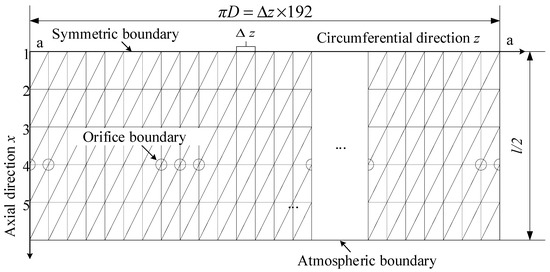
Figure 2.
Computational domain.
- (1)
- The atmospheric boundary represents the place where the gas is discharged into the environment (sp): , .
- (2)
- The symmetric boundary (ss) reads .
- (3)
- The orifice boundary condition or the micro-orifice boundary (sd): .
where ∂n denotes the direction of the normal of the symmetric boundary, and pd represents the restrictor outlet pressure. It should be emphasized here that in the boundaries pertinent to the second-order Reynolds equations, sp, ss, and sd represent the natural and enforced boundary conditions, respectively.
Based on FEM, the computational domain is appropriately discretized by the triangular element. Then the equation will be written as the sum of the integrals of the area of each element (Δe) in the following form:
The interpolation function based on FEM is explicitly expressed by
Substituting the interpolation function and the partial derivative of shape function into Equation (3), leads to
where , and the specific derivation process can be found in ref. [15].
By integrating the pressure of each element, the load capacity (W) and the attitude angle (φ) can be obtained, the stiffness (Kw) can be obtained via the difference method in the following form:
The above process is appropriately coded by MWORKS 2024b, and the obtained results are then utilized for further analysis.
3.2. Mesh-Independent Analysis
It is necessary to make a mesh-independent analysis to balance computational efficiency and accuracy. For this purpose, a comparison of different meshing configurations is presented in Table 1. It is noteworthy that the computational results demonstrate minimal improvements (less than 2.19%) with increasing mesh density, indicating that the 5×192 mesh configuration is sufficiently accurate and computationally efficient.

Table 1.
Mesh-independent analysis.
3.3. Experimental Validation
To validate the validity of the numerical model, a comparison was made between the computational results and the experimental data from ref. [5] is performed. The experimental setup involves a journal bearing, whose diameter is 25 mm, effective length is 50 mm, and the thickness of the air film is 12 μm. The bearing features two rows of orifice restrictors, with a total of 16 orifice restrictors with a diameter of 0.2 mm, and the source pressure was set to 0.5 MPa. As demonstrated in Table 2, the results for load capacity and stiffness results obtained from numerical analysis are in close agreement with the experiment, and the discrepancies do not exceed 5%, except for the case where the eccentricity ratio is 1/12. Due to the use of the difference methods for calculating the stiffness, the discrepancy in calculating the first stiffness is small; however, the overall deviation remains within an acceptable range. These comparison analyses confirm that the proposed numerical model is sufficiently reliable for further analysis and application.

Table 2.
Results of load capacity and stiffness according to experiment [5] and numerical analysis.
4. Simulation Results and Discussion
It is clear that a single restrictor design is not sufficient to demonstrate the benefits and mechanisms of MOR; therefore, two other sets of designs are utilized for comparison. The first set consists of TORs with a diameter of 0.2 mm, which are suitably arranged in two rows of eight orifices around the circumference. The second set consists of 0.05 mm diameter MOR, also evenly distributed around the circumference.
4.1. Static Performance
4.1.1. Performance Comparison
- (1)
- Pressure comparison
It is illustrated in Figure 3 that the dimensionless pressure distribution of the air film generated by three different restrictor configurations under an eccentricity ratio of 0.2 and an air supply pressure of 0.6 MPa, and the air film thickness is 15 μm. Each restrictor configuration has two rows of orifices. In Figure 3a, there are 8 orifices uniformly distributed in each row, with an orifice diameter of 0.2 mm, and an air chamber is designed at the outlet of each orifice to realize the orifice throttling, as shown in Figure 2a of reference [23]; in Figure 3b, there are 24 micro-orifices uniformly distributed in each row, with a micro-orifice diameter of 0.05 mm; in Figure 3c, there are 72 micro-orifice s in each row, with a group of three, and the inter-hole between each group are equal, with a micro-orifice diameter of 0.05 mm. As is shown in Figure 3, the dimensionless pressure distributions of different restricting methods are basically the same, the high-pressure area is concentrated between two rows of orifices. And it is noted that the pressure distribution of the micro-orifice restricted AJBs is smoother, and the pressure range is greater.

Figure 3.
Dimensionless pressure distributions of the air film by different restricted structure: (a) 8–0.2 mm, (b) 48–0.05 mm, (c) 24 × 3–0.05 mm.
As is obviously shown in Figure 4, all pressure distributions exhibit an approximately trapezoidal shape in two directions of the bearing. From the circumferential direction of the bearing, the trapezoidal profile arises from the uneven pressure distribution caused by the eccentricity. The stronger the force generated by the air film under eccentric conditions, the better the performance of the restrictors. In the axial direction, the pressure distribution is mainly affected by the arrangement of the restrictors, and the pressure drops rapidly as one moves from the restrictor locations to the atmospheric boundary, but remains relatively constant between the two rows of restrictors.
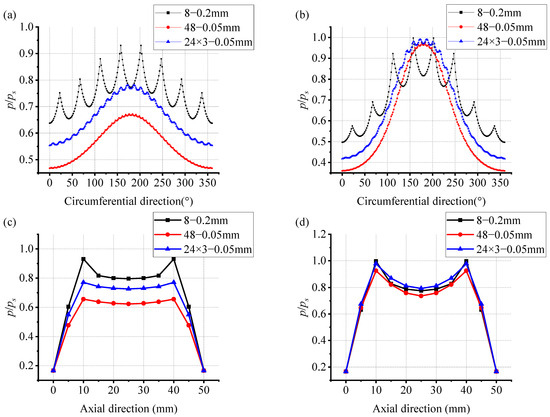
Figure 4.
Dimensionless pressure distribution of the air film from different directions: (a) eccentricity ratio: 0.2, (b) eccentricity ratio: 0.6, (c) eccentricity ratio: 0.2, (d) eccentricity ratio: 0.6.
Compared with the three-dimensional cloud diagrams, the line diagrams reflect more trends in a certain direction. The data in Figure 4a,c are extracted from the radial section A-A, which intuitively reflects the size relationship and trends of restrictor outlet pressure, and the comparison of the three restrictor design schemes is clearly presented. As illustrated in Figure 4a, the pressure difference between the orifices and the intervals in the AJBs with MOR is noticeably smaller, resulting in a more uniform pressure distribution. The micro-orifice restricting approach positively affects the formation of a more stable air film, and offers obvious advantages over traditional orifice restricting methods.
To explain the rule of the restrictor outlet pressure changes in Figure 4a,b, the air impedance theory is introduced, which is more intuitive and understandable. According to ISO 6358-1 [24], the ability of a pneumatic component or piping to conduct gas flow is defined as the conductivity (Ce), which can be determined based on the flow rate under standard reference atmospheric conditions (F), stagnation pressure, and the stagnation temperature ratio that produces the flow. The specific relationship is as follows:
where ρ1 represents the inlet air density.
To simplify derivation and design, the flow rate is usually expressed by the effective cross-sectional area (ECSA), representing a more practical measurement in engineering applications [25]. ECSA of the orifice refers to the cross-section area at the shrinkage of the orifice, whereas the equivalent cross-sectional area is utilized for irregular pneumatic components. According to ref. [25], the formula for flow rate as a function of ECSA is obtained can be derived:
where K denotes the flow coefficient related to the environment and state, Se represents the effective cross-sectional area of all restrictors, p1 and p2 in order are the inlet and outlet pressure, T1 is the absolute inlet stagnation temperature, and T0 is set equal to 293 K. Assuming that the flow rate per unit time is uniform and equal under the same operating conditions, Equation (9) could be rewritten based on the air impedance models shown in Figure 5 as follows:
where Sef represents the total ECSA of restrictors and air film, Sf denotes ECSA of the air film, and pd and Td in order are the outlet pressure and the absolute stagnation temperature of restrictors.

Figure 5.
Air impedance distribution in the AJB: (a) air impedance model of the micro-orifices, (b) air impedance model of restrictors and air film.
In addition, the total ECSA for the two main cases can be calculated in the following forms:
Parallel connection of MORs:
Serial connection of the restrictors and air film:
Due to the small diameter of the restrictor, the air flow velocity is very high, leaving no time for heat exchange. In addition, aerostatic bearings are usually equipped with a cooling system during operation, which allows the temperature ratio in Equation (9) to be considered as a constant. Then taking into account the connections of the various pneumatic components of Equation (12), we can rewrite Equation (10) in the following form:
It is known that the gas source pressure (ps) is a constant once selected, Sf is also constant after determining the thickness of the air film, and pa is the atmospheric pressure. Assuming that ECSA of a single orifice restrictor is denoted by S, and the micro-orifice diameter is 1/4 of the diameter of a traditional orifice, which leads to a proportional reduction in ECSA of a single micro-orifice restrictor to S/16. Obviously, the total ECSA of the MORs is noticeably lower than that of the TORs. From Equation (13), it can be inferred that as ECSA becomes smaller, the air film pressure decreases, which is consistent with the observed decrease in the MORs outlet pressures in Figure 4a,b. Furthermore, according to Equation (11), an increase in the number of micro-orifices causes an increase in Se, and consequently an increase in the air film pressure. According to the plotted results in Figure 4a,b, the 24 × 3 micro-orifices configuration exhibits higher outlet pressure values than the set of 48 micro-orifices, indicating that the simulation and mathematical analysis results are consistent.
As is illustrated in Figure 4c,d, the pressure fluctuations are smoother in the range of 10 cm to 40 cm along the bearing axial direction of the bearing. This region, which accounts for 60% of the total axial direction of the bearing, represents the pressure stability region between the two rows of restrictors outlets and acts as the main pressure-holding region of the AJB. In Figure 3, the pressure contours in this region exhibit consistent color and high values, indicating stable pressure distribution. Therefore, the pressure distribution in this region under various eccentricity ratios is chosen for further analysis, as illustrated in Figure 6.
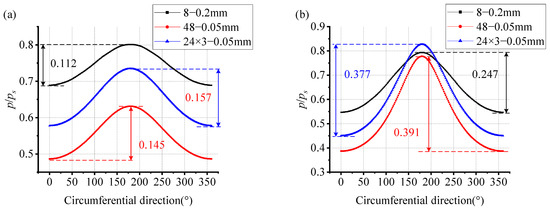
Figure 6.
Dimensionless pressure distributions of the main bearing area: (a) eccentricity ratio: 0.2, (b) eccentricity ratio: 0.6.
According to the plotted results in Figure 6, it is clear that the air films of the MOR-based AJBs exhibit larger pressure ranges compared to bearings with those of the bearings with orifice restrictors. Figure 6a displays the pressure distribution under an eccentricity ratio of 0.2, where the pressure ranges of the air film for the three restricting structures are predicted to be 0.112, 0.145, and 0.157, respectively. Similarly, in Figure 6b, the air film pressure ranges for the three restricting structures are obtained as 0.247, 0.391, and 0.377, respectively. It should be noted that although the MOR outlet pressures are reduced, the pressure range is actually increased, which can be available to improve the performance of AJBs.
- (2)
- Performance comparison
Figure 7 demonstrates the performance of the three restricting structures under different eccentricity ratios, including load capacity, stiffness and flow rate. As is illustrated in Figure 7a, the load capacity increases as the eccentricity ratio increases for all restricting structures. The MORs’ load capacity is always greater than TORs’, with a maximum increase of 49.6%. In addition, as illustrated in Figure 7b, in the range of eccentricity ratio below 0.7, the bearing stiffness of the micro-orifice restricting structure is able to maintain a high level and exhibits at least 21.3% improvement compared with the traditional orifice restricting structure. When the eccentricity ratio is less than 0.3, the 24 × 3 micro-orifice arrangement demonstrates higher load capacity and stiffness than those of the other two arrangements, which proves the rationality and advantages of this design.
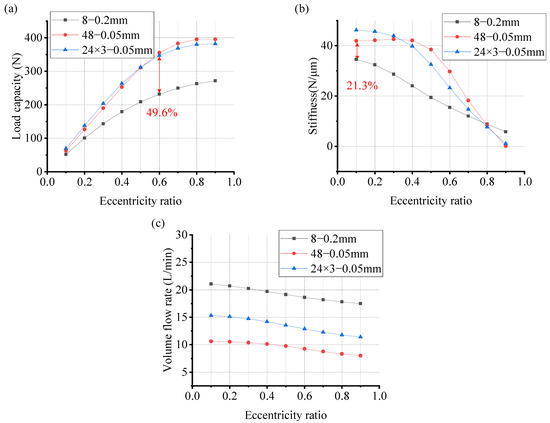
Figure 7.
Performances of three orifice arrangements in different eccentricity ratios: (a) Load capacity, (b) Stiffness, (c) Volume flow rate.
The pressure ranges of the three restrictors in the presence of eccentricity ratio of 0.2 and 0.6, as noted in Figure 6, determines the performance of the AJBs. The air film pressure range reflects the magnitude of the support force of the air film on the core shaft when there is an eccentric and indirectly reflects the performance of the bearing. It can be seen from Figure 7a that, under the eccentricity ratio of 0.2, the 24 × 3 MORs exhibits the highest load capacity, followed by the 48 uniformly distributed MORs, and finally the TORs. However, the load capacity of the 48 uniformly distributed micro-orifices restricting structure surpasses that of the 24 × 3 structure under the eccentricity ratio of 0.6. Both of the above sequences mentioned are consistent with what is presented in Figure 6, leading to the conclusion that MORs are help for the increase in the pressure range of the AJB’s air film, thereby enhancing the overall performance of the journal bearing.
Finally, through a comparison of the restricting area, micro-orifice restricting structures have smaller restricting area compared to traditional orifice restricting structures. This explains why the lower volume flow rate is exhibited in Figure 7c, and the flow rate reduces as the restricting area decreases. As a result, micro-orifice restricting structures achieve higher load capacity and stiffness while consuming less air.
4.1.2. Parametric Study
After comparing the MORs with TORs, a detailed investigation has been conducted on the MOR parameters. Several key parameters, including the micro-orifice diameter, supply pressure and air film thickness are appropriately adjusted to optimize the performance of the AJB.
- (1)
- Micro-orifice diameter and supply pressure
From Figure 8a,b, it is clear that when the micro-orifice diameter is 0.05 mm, the load capacity and stiffness performance of the AJB with micro-orifice are superior, and this result almost remains valid irrespective of the variations in the gas supply pressure. As the supply pressure changes, the bearing performance follows a similar trend to the changes in the orifice diameter. When the diameter reduces, the load capacity and stiffness first increase and then decrease, whereas the air consumption continues to decrease. Furthermore, it is observed that the influence of changes in supply pressure on the characteristics of the AJB lessens with the reduction in the micro-orifice diameter to lower than 0.05 mm.
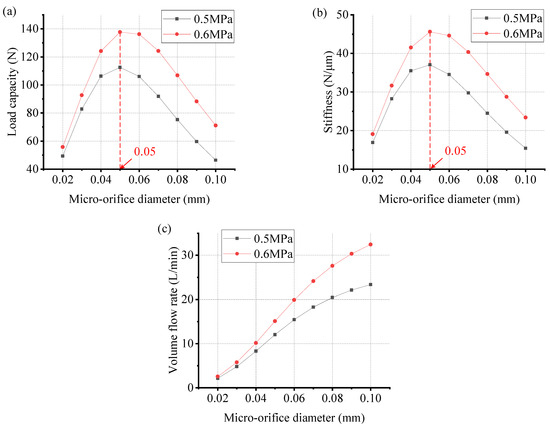
Figure 8.
Effect of micro-orifice diameter on bearing performance: (a) Load capacity, (b) Stiffness, (c) Volume flow rate.
- (2)
- Thickness of the air film
As illustrated in Figure 9a, the influence of changes in the thickness of the air film on the load capacity follows a consistent trend: they increase at first and then decrease, reaching a peak at an air film thickness of approximately 15 μm. The influence of changes in air film thickness also causes the stiffness to increase first and then decrease. In addition, a higher eccentricity ratio requires a thicker air film to achieve maximum stiffness. In engineering applications, the selection of the air film thickness is usually accomplished to achieve higher stiffness, for example, under an eccentricity ratio of 0.2, the optimal air film thickness will be 12 μm, as illustrated in Figure 9b.
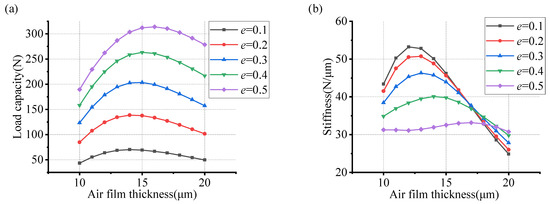
Figure 9.
Effect of air film thickness on bearing performance (e is the eccentricity ratio): (a) Load capacity, (b) Stiffness.
4.2. High-Speed Performance
4.2.1. Centrifugal Effect
As introduced in Section 1, AJBs exhibit completely different characteristics compared with thrust bearings under dynamic conditions. Therefore, the study of the performance of journal bearings at high speeds cannot be ignored. Additionally, it is known that the air film will generate centrifugal deformation as the core shaft operates at high-speed. Therefore, the simulation and analysis of the centrifugal deformation helps to select an appropriate thickness of the air film, thereby improving the results of the bearing calculation model. The core shaft material used in this paper is 38CrMoAl, the material density is 7.85 g/cm3 and the elastic modulus is 210 GPa. Figure 10a shows the dimensional parameters of the core shaft. Figure 10b demonstrates the simulation results for a core shaft speed of 60,000 r/min by ANSYS 2022, where the location of the journal bearings is marked with red boxes.
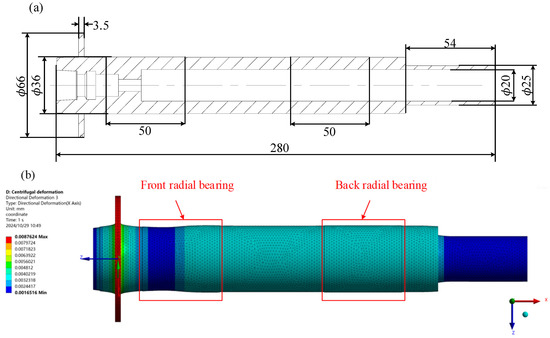
Figure 10.
Centrifugal deformation: (a) shaft dimensions (Length Unit: mm), (b) simulation results.
In the process of determining the thickness of journal bearings air film, the deformation caused by the high-speed centrifugal expansion of the core shaft should be fully considered. As illustrated in Figure 11, the centrifugal deformation at a speed of 60,000 r/min is obtained as 3.855 μm, and in designing the air film thickness, this deformation should be considered to ensure the optimal thickness. Based on the bearing stiffness analysis, the optimal air film thickness is predicted to be 12 μm, as demonstrated in Figure 9b. Therefore, for an aerostatic spindle operating at a speed of 60,000 r/min, the air film thickness should be set to 15–16 μm to mitigate the reduction in deformation of the air film thickness caused by the dynamic effects.
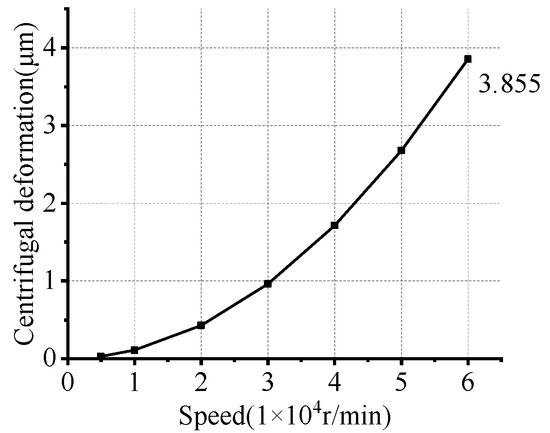
Figure 11.
Centrifugal deformation of AJB.
4.2.2. Performance Comparisons
To illustrate the influence of centrifugal deformation on bearings, the dimensionless pressure distribution in two directions under various operating conditions is compared. As illustrated in Figure 12, the pressure increases significantly when the centrifugal deformation is considered in the design, reaching a maximum of 41%, which critically improves the performance of the AJB. Moreover, as shown in Figure 13, due to the dynamic pressure effect, the AJB at 60,000 r/min has higher load capacity and stiffness than that under static conditions. In addition, after considering the centrifugal deformation, not only are the load capacity and stiffness substantially enhanced, but also the air consumption is significantly reduced. Furthermore, the attitude angle becomes more stable compared to the case where the centrifugal deformation is ignored, emphasizing the importance of including the centrifugal deformation factors in the calculation and design process.
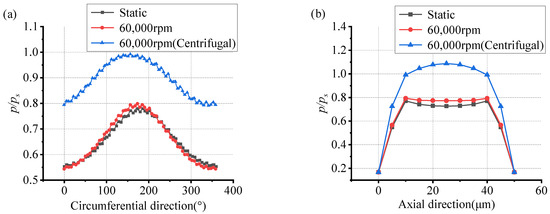
Figure 12.
Dimensionless pressure distributions of different operating conditions (under the eccentricity ratio of 0.2, supply pressure of 0.6 MPa and air film thickness of 15 μm) : (a) Circumferential direction, (b) Axial direction.
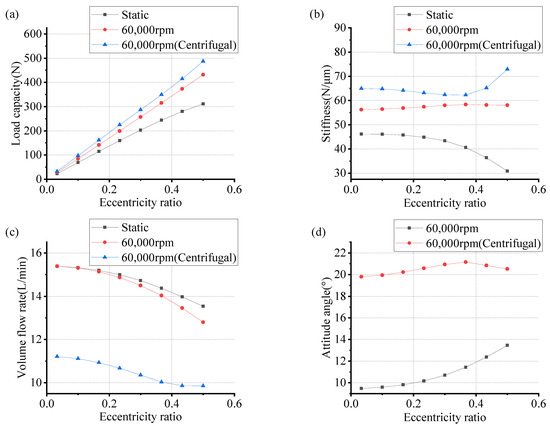
Figure 13.
Performance of journal bearing in different operating conditions: (a) Load capacity, (b) Stiffness, (c) Volume flow rate, (d) Attitude angle.
4.3. Experiment Setup and Results
It is difficult to apply a load to the spindle and accurately measure the corresponding displacement and other characteristics at high speed, while it is relatively convenient to measure the volume flow rate. Therefore, this paper considers the dead weight of the rotor and the motor as the load to estimate the eccentricity, and the centrifugal deformation of the rotor obtained by simulation in the presence of various rotational speeds serves as a reference to recalculate the air film thickness. Subsequently, the rationally established mathematical model in this paper is employed to evaluate the volume flow rate under different rotational speeds. To this end, the experimental device in Figure 14 is constructed to measure the volume flow rate.
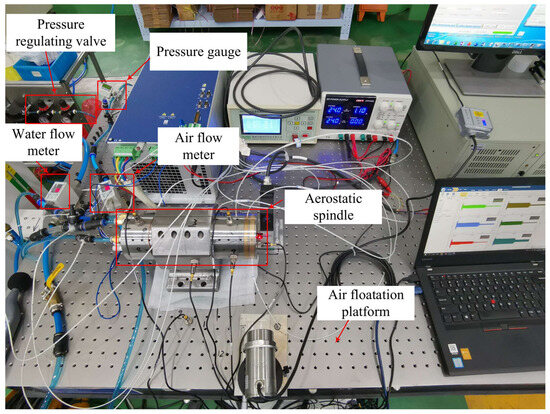
Figure 14.
Equipment for measuring volume flow rate at different rotating speeds.
The pressure-reducing valve, the pressure gauge and the air flow meter in Figure 14 are from SMC. The gas is produced by an air compressor and passes through the filters, then passing through the three devices mentioned above. The pressure-reducing valve is utilized to adjust the supply pressure, the pressure gauge is used to read the pressure value, and the air flow meter is employed to measure volume flow rate. Because the bearings with micro-orifices have not been manufactured yet, another spindle is used to verify the calculation method. The bearing parameters of the spindle used in the experiment, presented in Figure 14, are shown in Table 3. The front and rear journal bearings are composed of four rows of orifices, 12 orifices for each row. The dead weight of the shaft and motor is 10.4468 N. The total load capacity of the two bearings is equal to the dead weight of the rotor and motor. The load capacities of the front and rear bearings are calculated at specified rotational speeds with varied eccentricity ratios, and the eccentricity ratio can be obtained under the condition that the load capacity is equal to the weight of the shaft and the motor. In this way, the eccentricity ratio at different speeds can be calculated, so that subsequent calculations can be realized. The rotation speed of the spindle can be adjusted by the driver; the volume flow rate of the spindle is recorded every 10,000 r/min.

Table 3.
The bearing parameters of the spindle used in the experiment.
The experimental results and the numerical calculation data are plotted in Figure 15 to make a comparison. By comparing the conclusions with the predictions of the mathematical model, the rationality and effectiveness of the proposed method could be accurately validated.
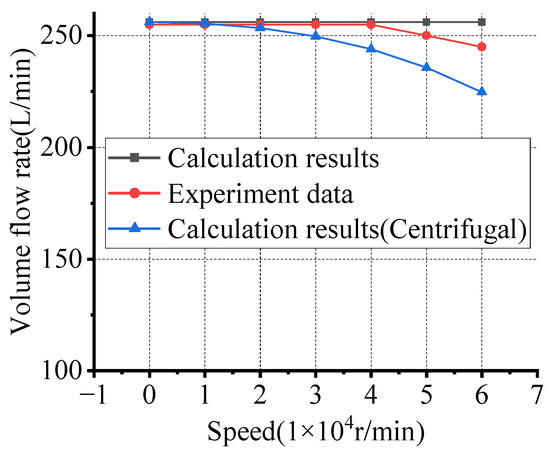
Figure 15.
Comparison of experimental and computational results.
As illustrated in Figure 15, the error between the calculated data of the proposed model and the experimental results does not exceed 8.3%, which proves the reasonableness of the model. As the centrifugation is not considered, the volume flow rate does not alter with the change in the rotation speed, and its value is almost stable. After considering the centrifugal effects, with the growth of spindle speed, the dynamic pressure effect gradually intensifies, and the trend of volume flow rate reduction becomes increasingly apparent. Such a result is consistent with the experimental data and illustrates the conclusions and methods regarding the centrifugal effects presented in this paper.
5. Conclusions
The nonlinear compressible Reynolds equation was formulated and solved by the Galerkin method and FEM, with special attention to the solution including the velocity term. The numerical models were developed for various performance indices of AJBs, and the reliability of the numerical models was also verified through comparison with experiment from the literature. The advantages of the micro-orifice restricting approach were then methodically examined, and the effect of different design factors on the micro-orifice restricting effect was explored. In addition, the specific dynamic effects of AJBs were investigated, and the centrifugal deformation was integrated into the aerostatic spindle computation process. The obtained conclusions are summarized as follows:
- (1)
- Compared with orifice restricting structures, micro-orifice restricting structures exhibit smaller pressure differences between the orifices and the intervals, such that the pressure distribution becomes more uniform. Using the gas impedance model, it was found that the reduction in the effective cross-sectional area leads to a reduction in the outlet pressure of the restrictors.
- (2)
- The MOR-based structure demonstrates superior performance in AJBs, characterized by a uniform and stable air film, higher load capacity and stiffness, and reduced volume flow rate. In addition, the 24×3 MORs configuration increases the number and density of micro-orifices and shows better performance under eccentricity ratios less than 0.3. These improvements are closely related to the pressure range of the main bearing area; a larger pressure range leads to a larger reaction force, thereby increasing the load capacity and stiffness.
- (3)
- The performance trend of AJBs with MOR is not uniform with respect to the micro-orifice diameter, whose recommended value for journal bearings is 0.05 mm because smaller diameters will lead to reduced sensitivity of bearing performance to supply pressure changes.
- (4)
- The centrifugal deformations of the air film are analyzed for high-speed operations. By combining this analysis with the air film thickness under various eccentricity ratios, a more realistic and suitable air film thickness for AJBs is obtained. The proposed numerical model confirmed that the dynamic performance of the spindle is enhanced by utilizing this specific thickness. And the final experiment also reveals that accounting for the centrifugal effect brings calculated results into closer alignment with the actual measured values.
Author Contributions
Conceptualization, S.G.; methodology, Z.L. and H.Y.; software, M.Z.; validation, Z.L., T.J. and Q.G.; formal analysis, T.J.; investigation, L.S.; resources, S.G. and L.L.; data curation, Z.L.; writing—original draft preparation, Z.L.; writing—review and editing, S.G.; visualization, J.Y.; supervision, S.G.; project administration, J.Y.; funding acquisition, H.Z. All authors have read and agreed to the published version of the manuscript.
Funding
The authors thank for the funding support for this research by the National Key Research and Development Program of China (Grant No. 2022YFB3402705) and the National Special Project of China, (Grant No. 2023ZY01077) and the Key Research and Development Program of Heilongjiang Province, (Grant No. 2022ZX03A05) and the Chongqing Natural Science Foundation, (Grant No. CSTB2024NSCQ-MSX0820) and Manufacturing Science and Technology Innovation Talent Project of Harbin, (Grant No. 2023CXRCGD028).
Data Availability Statement
The data that support the findings of this study are available from the corresponding author.
Conflicts of Interest
Author Hanqian Zhang was employed by the company Guangzhou Haozhi Industrial Co., Ltd. The remaining authors declare that the research was conducted in the absence of any commercial or financial relationships that could be construed as a potential conflict of interest.
References
- Gao, Q.; Chen, W.; Lu, L.; Huo, D.; Cheng, K. Aerostatic bearings design and analysis with the application to precision engineering: State-of-the-art and future perspectives. Tribol. Int. 2019, 135, 1–17. [Google Scholar] [CrossRef]
- Zhuang, H.; Ding, J.; Chen, P.; Chang, Y. Improved modeling method of inherently compensated aerostatic thrust bearings considering pressure depression. Precis. Eng. 2024, 89, 276–295. [Google Scholar] [CrossRef]
- Miettinen, M.; Vainio, V.; Theska, R.; Viitala, R. Aerostatically sealed chamber as a robust aerostatic bearing. Tribol. Int. 2022, 173, 107614. [Google Scholar] [CrossRef]
- Cheng, Y.; Li, D.; Hu, J.; Li, J. Theoretical study and experimental verification on calculation of bearing capacity of aerostatic restrictor system with a gas-impedance model. In Proceedings of the Ninth International Symposium on Precision Engineering Measurement and Instrumentation, Changsha, China, 8–10 August 2014. [Google Scholar]
- Xiao, H.; Li, W.; Zhou, Z.; Huang, X.; Ren, Y. Performance analysis of aerostatic journal micro-bearing and its application to high-speed precision micro-spindles. Tribol. Int. 2018, 120, 476–490. [Google Scholar] [CrossRef]
- Li, W.; Wang, S.; Zhao, Z.; Zhang, K.; Feng, K.; Hou, W. Numerical and experimental investigation on the performance of hybrid porous gas journal bearings. Lubr. Sci. 2021, 33, 60–78. [Google Scholar] [CrossRef]
- Zhang, J.; Han, D.; Song, M.; Xie, Z.; Rao, Z.; Zou, D. Theoretical and experimental investigation on the effect of supply pressure on the nonlinear behaviors of the aerostatic bearing-rotor system. Mech. Syst. Signal Process. 2021, 158, 107775. [Google Scholar] [CrossRef]
- Chen, X.; Mills, J.K.; Shi, K.; Bao, G. Numerical investigation on the static performance of aerostatic journal bearings with different pocket shapes by the finite-element method. Proc. Inst. Mech. Eng. Part J J. Eng. Tribol. 2020, 235, 1897–1911. [Google Scholar] [CrossRef]
- Vainio, V.; Miettinen, M.; Majuri, J.; Theska, R.; Viitala, R. Manufacturing and static performance of porous aerostatic bearings. Precis. Eng. 2023, 84, 177–190. [Google Scholar] [CrossRef]
- Deb, R.; Hunkeler, A.; Wilhelm, D.; Jenny, P.; Meier, B.H. Numerical modeling and design decisions for aerostatic bearings with relatively large nozzle sizes in Magic-Angle Spinning (MAS) systems. Tribol. Int. 2022, 175, 107855. [Google Scholar] [CrossRef]
- Abdel-Rahman, G.M. Studying fluid squeeze characteristics for aerostatic journal bearing. Phys. B Condens. Matter 2008, 403, 2390–2393. [Google Scholar] [CrossRef]
- Chen, Y.S.; Chiu, C.C.; Cheng, Y.D. Influences of operational conditions and geometric parameters on the stiffness of aerostatic journal bearings. Precis. Eng. 2010, 34, 722–734. [Google Scholar] [CrossRef]
- Wang, X.; Zhou, L.; Huang, M.; Yue, X.; Xu, Q. Numerical investigation of journal misalignment on the static and dynamic characteristics of aerostatic journal bearings. Measurement 2018, 128, 314–324. [Google Scholar] [CrossRef]
- Wang, X.; Xu, Q.; Huang, M.; Zhang, L.; Peng, Z. Effects of journal rotation and surface waviness on the dynamic performance of aerostatic journal bearings. Tribol. Int. 2017, 112, 1–9. [Google Scholar] [CrossRef]
- Gao, S.; Cheng, K.; Chen, S.; Ding, H.; Fu, H. Computational design and analysis of aerostatic journal bearings with application to ultra-high speed spindles. Proc. Inst. Mech. Eng. Part C J. Mech. Eng. Sci. 2017, 231, 1205–1220. [Google Scholar] [CrossRef]
- Belforte, G.; Colombo, F.; Raparelli, T.; Trivella, A.; Viktorov, V. Experimental Analysis of Air Pads with Micro Holes. Tribol. Trans. 2013, 56, 169–177. [Google Scholar] [CrossRef]
- Miyatake, M.; Yoshimoto, S. Numerical investigation of static and dynamic characteristics of aerostatic thrust bearings with small feed holes. Tribol. Int. 2010, 43, 1353–1359. [Google Scholar] [CrossRef]
- Chen, X.; Chen, H.; Zhu, J.; Jiang, W. Vortex suppression and nano-vibration reduction of aerostatic bearings by arrayed microhole restrictors. J. Vib. Control. 2016, 23, 842–852. [Google Scholar] [CrossRef]
- Wang, G.; Li, W.; Liu, G.; Feng, K. A novel optimization design method for obtaining high-performance micro-hole aerostatic bearings with experimental validation. Tribol. Int. 2023, 185, 108542. [Google Scholar] [CrossRef]
- Fan, G.; Li, Y.; Li, Y.; Zang, L.; Zhao, M.; Li, Z.; Yu, H.; Xu, J.; Liang, H.; Zhang, G.; et al. Research on Design and Optimization of Micro-Hole Aerostatic Bearing in Vacuum Environment. Lubricants 2024, 12, 224. [Google Scholar] [CrossRef]
- Wu, Y.; Li, C.; Li, J.; Du, J. Lubrication mechanism and characteristics of aerostatic bearing with close-spaced micro holes. Tribol. Int. 2024, 192, 109278. [Google Scholar] [CrossRef]
- Liu, T.; Liu, Y.; Chen, S. Aerostatic Lubrications; Press of Harbin Institute of Technology: Harbin, China, 1990. [Google Scholar]
- Gao, S.; Cheng, K.; Ding, H.; Fu, H. Multiphysics-based design and analysis of the high-speed aerostatic spindle with application to micro-milling. Proc. Inst. Mech. Eng. Part J J. Eng. Tribol. 2016, 230, 852–871. [Google Scholar] [CrossRef]
- ISO 6358-1:2013(E); Pneumatic Fluid Power—Determination of Flow-Rate Characteristics of Components Using Compressible Fluids. International Organization for Standardization: Geneva, Switzerland, 2013.
- Cai, M. Modern Pneumatic Technology Theory and Practice Lecture 1: Flow Characteristics of Pneumatic Components. Hydraul. Pneum. Seals 2007, 27, 44–48. [Google Scholar]
Disclaimer/Publisher’s Note: The statements, opinions and data contained in all publications are solely those of the individual author(s) and contributor(s) and not of MDPI and/or the editor(s). MDPI and/or the editor(s) disclaim responsibility for any injury to people or property resulting from any ideas, methods, instructions or products referred to in the content. |
© 2025 by the authors. Licensee MDPI, Basel, Switzerland. This article is an open access article distributed under the terms and conditions of the Creative Commons Attribution (CC BY) license (https://creativecommons.org/licenses/by/4.0/).